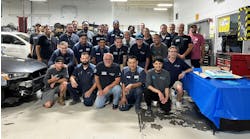Up for Debate
Estimates on the shortage of technicians range from 35,000 to 60,000 per year depending on the source, according to Richard White, senior vice president, marketing and member relations, Automotive Aftermarket Industry Association (AAIA). This discussion has been ongoing. Like vehicle service and repair businesses, he says every industry is always looking for educated, skilled, talented, and experienced professionals.
Part of the debate within the automotive industry is whether there is an overall shortage of technicians or a shortage of qualified technicians. There are plenty of people can change oil and tires and perform basic, entry-level service, but it's the computer-savvy techs that can perform diagnostics that are in short supply.
"There is an argument that suggests some standard methods used to analyze a labor shortage don't seem to exist when it comes to automotive technicians," said White. "I would think if there were a technician shortage we would notice consumers waiting longer for maintenance and repairs. We would see cars lined up in the lots, increased costs of maintenance and repair, and technicians demanding and receiving higher pay and more benefits. I don't believe any other these things are currently happening."
However, the aftermarket industry will eventually fall victim to very real demographic trends and overall manpower shortages. "Consider these facts: 16 percent of the U.S. workforce will be 55 and older in two years and 10,000 Americans will turn 65 every day by 2012. By 2030, one out of every four Americans will be 65 or older. Over the next 10 years one half of the top technicians will retire," said White.
So, it appears the real discussion should be about the future technician shortage that will reflect the forecast for an overall manpower shortage. Competition for educated, talented, skilled, young people is a real issue for the industry at all levels as every industry competes for these people.
"Our industry's biggest obstacle in competing for the same talent as other industries is perception of the job of being an automotive technician," said White. "The gatekeepers for prospective technicians are the parents, friends, peers, and guidance counselors, all of whom probably have a negative perception about career opportunities and realities for auto technicians."
White strongly believes the solution is local and not national. "I get so tired of hearing people in the industry calling for a national PR campaign to improve the image of the automotive technician profession. The image and perception should be dealt with at the local level, community by community; not by a brochure or video as part of a campaign. It's impossible to cut through all the clutter of messages out there today; it needs to be more viral."
The quality repair shops are involved with schools in their community and are willing to mentor young people. They pay their employees fairly and run a clean, professional business. They treat their employees with respect, and in turn, their employees have a positive self-image that is portrayed to colleagues and customers.
The Best and Brightest
A repair facility's number one job is identifying, acquiring, and keeping quality technicians, according to Dave Skaien, program development manager, Automobile Association of America (AAA). The only thing that's harder to do is to keep up with the technology with which technicians need to be able to maintain.
"I'm not sure enough steps are being taken to fulfill the need for quality technicians especially considering the requirements technicians will need to have moving forward," said Skaien. "Historically, going back to high school, if you were a sharp, upwardly mobile kid, you were pointed into the professional fields and if you were an at-risk kid who didn't have a good shot at society you were pointed to vocational ed classes with the thinking maybe you could go fix cars."
But nowadays, it's the exact opposite, according to Skaein. With increasingly complex and computerized systems, to get into diagnostics and repair, it's the brightest kids who are going into the automotive field. "To work on a modern automobile a technician must have a diverse background and understand electrical, mechanical, and automotive engineering," he said.
There are many factors pulling away from the pool of viable technicians. In addition to the anticipated retirement of Boomer-generation technicians, many move on to service writing, service management, and shop ownership.
According to Skaien, hiring and retention bonuses and better benefits packages are becoming more prevalent to entice potential employees. In addition, the stigma associated with being an automotive technician needs to be addressed. "There is great income potential and job security. The outlook for someone who wants to come into this industry is probably the best it's ever been," said Skaien.
Supply and Demand
According to Tony Molla, VP of communications, the National Institute for Automotive Service Excellence, American trade schools are graduating about 35,000 new technicians this year. "According to some industry analysts, we need double that number. It's also true that nobody has had any trouble getting their car fixed lately, so people question the validity of there actually being a shortage in some quarters," he said.
There are several mitigating factors that mask the problem, including the fact cars are built better and require less service and repair than ever before to keep their highly technical systems operating properly. Vehicles are becoming more complex with several different powertrain options, including diesel, gas hybrid, and alternative fuels. They are also becoming more electronically controlled.
"The inescapable fact is, according to Department of Labor statistics, about 50 percent of current technicians will be eligible for retirement in the next 7-12 years," said Molla. "So, the shortage, while it may not be manifesting itself now, is a situation where as the acceleration of baby Boomer retirements increase the shortfall will become much more apparent."
Once the Boomers retire, the law of supply and demand should kick in. The harder technicians are to find, the more salaries will be driven upward as shops bid against one another for qualified service technicians. This may lead to fewer repair shops, which, according to Molla, is not necessarily a bad thing because those technicians would go to work in the remaining shops thereby lessening the impact of the technician shortage.
To address the problem, active recruitment programs are held across the country by various organizations, including the Alliance of Automotive Service Providers (AASP), Automotive Aftermarket Industry Association (AAIA), and Automotive Service Association (ASA).
"The sharp shops -- the ones that have the least problems with hiring -- have joined their local advisory council so they get the pick of the litter of the students coming out of the vocational education system," said Molla.
At career day activities, young recruits are told a career as a technician can be a gateway to a host of other careers in the automotive industry. According to Molla, today's recruits are much more mobile than previous generations and an automotive career can be appealing to them if they understand the possibilities down the road.
Although starting salaries straight out of vocational tech school average between $22,000-$25,000 per year, median annual salaries are between $45,000-$65,000 with the potential to earn $75,000 and up. "It is possible to earn six figures but they're definitely the exception, not the rule," said Molla. "They're extremely good diagnosticians, they have their own test equipment, they've invested in their career, they're always going to training, and they generally work for high-end import dealerships."
While the automotive industry struggles, competition is fierce in many skilled trades, including plumbing, medicine, and law, where professionals have been in the business for a while and are reaching retirement age.




